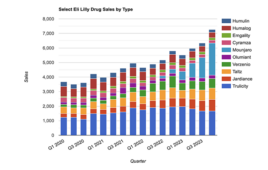Scientists in the U.S. have developed a novel vaccination method that uses tiny gold particles to mimic a virus and carry specific proteins to the body’s specialist immune cells.
The technique differs from the traditional approach of using dead or inactive viruses as a vaccine and was demonstrated in the laboratory using a specific protein that sits on the surface of the respiratory syncytial virus (RSV).
The results have been published in Nanotechnology by a team of researchers from Vanderbilt Univ.
RSV is the leading viral cause of lower respiration tract infections, causing several hundred thousand deaths and an estimated 65 million infections a year, mainly in children and the elderly.
The detrimental effects of RSV come, in part, from a specific protein, called the F protein, which coats the surface of the virus. The protein enables the virus to enter into the cytoplasm of cells and also causes cells to stick together, making the virus harder to eliminate.
The body’s natural defence to RSV is therefore directed at the F protein; however, up until now, researchers have had difficulty creating a vaccine that delivers the F protein to the specialised immune cells in the body. If successful, the F protein could trigger an immune response which the body could ‘remember’ if a subject became infected with the real virus.
In this study the researchers created exceptionally small gold nanorods, just 21 nanometers wide and 57 nanometers long, which were almost exactly the same shape and size as the virus itself. The gold nanorods were successfully coated with the RSV F proteins and were bonded strongly thanks to the unique physical and chemical properties of the nanorods themselves.
The researchers then tested the ability of the gold nanorods to deliver the F protein to specific immune cells, known as dendritic cells, which were taken from adult blood samples.
Dendritic cells function as processing cells in the immune system, taking the important information from a virus, such as the F protein, and presenting it to cells that can perform an action against them―the T cells are just one example of a cell that can take action.
Once the F protein-coated nanorods were added to a sample of dendritic cells, the researchers analysed the proliferation of T cells as a proxy for an immune response. They found that the protein-coated nanorods caused the T cells to proliferate significantly more compared to non-coated nanorods and just the F protein alone.
Not only did this prove that the coated-nanorods were capable of mimicking the virus and stimulating an immune response, it also showed that they were not toxic to human cells, offering significant safety advantages and increasing their potential as a real-life human vaccine.
Lead author of the study, Prof. James Crowe, said: “A vaccine for RSV, which is the major cause of viral pneumonia in children, is sorely needed. This study shows that we have developed methods for putting RSV F protein into exceptionally small particles and presenting it to immune cells in a format that physically mimics the virus. Furthermore, the particles themselves are not infectious.”
Due to the versatility of the gold nanorods, Prof. Crowe believes that their potential use is not limited to RSV.
“This platform could be used to develop experimental vaccines for virtually any virus, and in fact other larger microbes such as bacteria and fungi.
“The studies we performed showed that the candidate vaccines stimulated human immune cells when they were interacted in the lab. The next steps to testing would be to test whether or not the vaccines work in vivo,” Crowe continued.
Source: Institute of Physics
Filed Under: Drug Discovery




